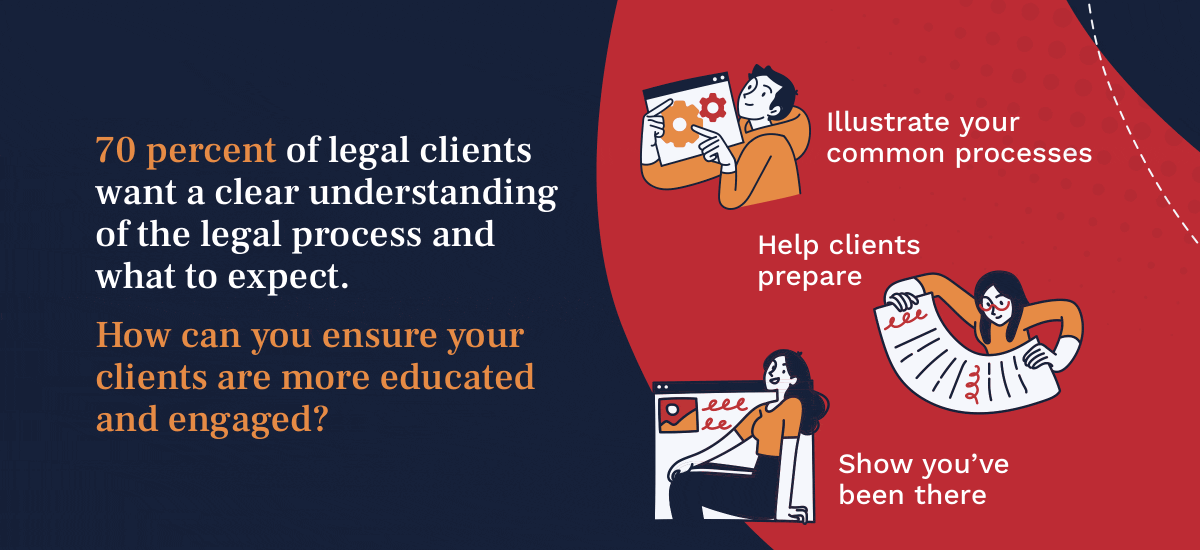Imagine this: You hurt your knee, and you’re scouting orthopedic surgeons.
The first doctor you see tells you “Every knee is different, I’ll just have to open you up and go from there.” When you ask how long recovery may take, he shrugs: “It depends.”
The second doctor, meanwhile, takes out a 3-D model of a knee joint and shows you exactly where she would cut. When you ask about recovery, she discusses the factors that could affect the timing—swelling, reaction to anesthesia, complications, pre-surgery fitness, et cetera—but then says that based on her experience doing exactly this type of surgery, she estimates six to eight weeks. She leaves you with a pamphlet that shares what you’ll need to do before and after surgery.
Which doctor do you choose?
Your prospective legal clients are in the same situation—and while the injury may not be as literal as a torn meniscus, they are seeking reassurance from an experienced expert.
Indeed, in a Clio survey, 70 percent of legal clients said they want a clear understanding of the legal process and what to expect—more than the 66 percent who want a total cost estimate.
While every case is different and should be evaluated on its own merits, the lawyers who can manage expectations in the scouting stage will be better positioned to get hired—and may also find themselves with more educated, engaged clients.
Consider taking these three steps:
Illustrate your common processes
Creating an ESOP or filing a contract dispute may be second nature to you—but it’s not for your client. Distilling the key steps into a one-page infographic provides a powerful visual and helps the client understand both every step and the big picture.
Documenting a “Proven Process” is a critical component of the Entrepreneurial Operating System, or EOS, which advises: “It’s your process that has proven over and over again to provide consistent, predictable results. And when shared with prospective customers, their questions and hesitancies are alleviated.”
EOS recommends:
- Tell the client their story and what it will be like to work with you.
- Make it visual with very few words.
- Communicate the process in five to seven milestones.
Law firm example: AEON Law, an IP boutique in Seattle, posts its Trademark Process on its website. Potential clients can see the main steps involved, from Discovery to Registration to Monitoring.
Help clients prepare
Do you find yourself answering the same questions repeatedly? Do you regularly need the same types of documents or information?
Make the beginning stages of a matter easier on both you and the client by offering some guidance. Most clients want to feel in control, and want to be actively working to advance their cause; help translate their nervous energy into action with education and direction.
Posting your answers to Frequently Asked Questions on your website may eliminate some back and forth (and provides a resource that clients can look back to if and when they forget part of your discussion). And giving clear homework assignments may allow for a more efficient and effective kickoff meeting.
Law firm examples: Fisher Law, a family law firm in Kansas City, clearly tells clients to “bring this form to your initial meeting.” Astley Putnam, a family law firm in Omaha, has a “How to Get Started” page with helpful FAQs.
On the corporate side, SECIL Law, a white-collar criminal defense and securities law boutique, categorizes its FAQs by client type, so visitors can self-identify as a Company Owner, Financial Advisor, and more.
Show you’ve been there.
In the same Clio survey, 77 percent of prospective clients said they want to know a lawyer’s experience and credentials, and 72 percent want to know what types of cases they handle.
Again, every case is different, but how can you show you are a safe choice for this type of problem?
- Ensure that your bio is up to date with relevant content and representative work highlights.
- Pursue awards and rankings that provide third-party endorsement of your capabilities.
- Draft thorough case studies (with client permission!) that allow your prospects to see themselves in your results. These should go beyond the “Handled matter for client” bullet point to explain the situation, stakes and solution.
The Clio survey provides one last compelling argument as to why law firms should prepare these types of marketing materials: Failing to do so can lose you business.
Clio asked survey respondents why they did not hire a lawyer they reached out to, and nearly two-thirds, 65 percent, didn’t get any indication on what to do next; another 62 percent didn’t understand the process for their case; and 61 percent didn’t get information they could understand.
Let’s revisit the orthopedic surgeon analogy. Lawyers who take the time to elevate their bedside manner with models and educational materials will be better positioned to close—and better connected to informed, proactive clients.

